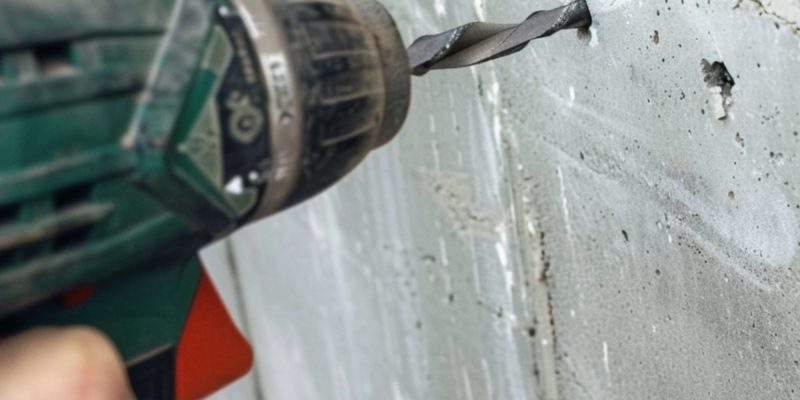Welcome to our guide on how to drill into concrete, a task that might seem daunting at first but is entirely manageable with the right approach. Whether you’re looking to hang shelves, mount a TV, or start a home renovation project, drilling into concrete is a skill you’ll find invaluable. We aim to walk you through each step of the process, ensuring you can tackle this challenge with confidence. Let’s get started!
Understanding Concrete Drilling
Concrete is a tough material, made from a mix of water, cement, sand, and gravel. This combination makes it incredibly durable and resistant to wear and tear, which is why it’s used so widely in construction. However, its hardness also means that drilling into concrete requires special tools and techniques.
Challenges in Drilling
One of the main challenges in drilling into concrete is its density and the presence of aggregate (small stones) that can dull drill bits quickly. Additionally, concrete can vary in hardness depending on its age and the specific mix used, making some concrete surfaces harder to drill into than others.
Reasons for Drilling Concrete
There are several reasons you might need to drill into concrete:
- Anchoring Objects: For stability and security, such as mounting TVs or hanging heavy artwork.
- Home Improvement Projects: Installing shelves, cabinets, or curtain rods.
- Professional Construction Needs: Creating spaces for wiring, plumbing, or structural anchors in larger projects.
Necessary Tools
The right tools make all the difference when drilling into concrete. Here’s what you’ll need:
Hammer Drill vs. Rotary Hammer: A hammer drill is suitable for small, home-based projects. It combines rotation with a hammering action to break through concrete. A rotary hammer is more powerful and better suited for larger projects, using a piston mechanism for drilling.
Masonry Bits: These bits have a tip designed to crush concrete and are essential for effective drilling. The size of the bit should match the size of the hole you’re aiming to drill.
Safety Gear: Protective eyewear, dust masks, gloves, and ear protection are non-negotiable to safeguard against concrete dust and noise.
Prepping to Drill
Before you start drilling, preparation is key:
Marking the Spot: Use a pencil or marker to clearly indicate where you want to drill. For precision, you can use a center punch to create a small indentation, which prevents the drill bit from slipping.
Choosing the Right Bit: Select a masonry bit that matches the diameter and depth of the hole you need.
Tool Setup: Ensure your drill is in hammer mode and that the bit is securely fastened.
Safety Measures
When drilling into concrete, prioritizing safety is crucial. Here’s how to protect yourself:
Protective Gear – Always wear goggles to shield your eyes from flying debris. Dust masks are essential to prevent inhalation of fine concrete dust, which can be harmful over time.
Gloves protect your hands from vibration and abrasions, while ear protection is necessary to guard against the loud noise produced by drilling.
Dust Management – Concrete dust can be hazardous, so managing it is important. Using a vacuum system attached to your drill can help capture dust at the source. Alternatively, periodically stopping to clean up dust with a wet/dry vacuum can also minimize exposure.
NOTE
Simple yet effective safety measures can significantly reduce the risks associated with drilling into concrete, ensuring a safer DIY project or construction task.
Step-by-Step Drilling Process
Drilling into concrete is straightforward when you follow these steps:
Step 1: Starting the Hole
Place the tip of your masonry bit at the marked spot on the concrete. Start the drill at a low speed to establish the hole, gradually increasing speed as you go deeper. Applying gentle pressure lets the tool do the work without overheating.
Step 2: Drilling Technique
Maintain steady pressure and keep the drill straight to ensure the hole is even. If you encounter resistance, pull the drill bit out slightly and then continue, which helps clear debris from the hole.
Step 3: Dealing with Resistance
Hitting a particularly tough spot or aggregate in the concrete? Don’t force the drill. Instead, withdraw the bit slightly and try again with steady pressure. Sometimes changing to a slightly smaller bit can help make a pilot hole before using the intended size.
Step 4: Depth Measurement
To drill to the correct depth, wrap a piece of tape around the drill bit at the desired depth as a visual guide. This prevents drilling deeper than necessary.
By following these steps, you’ll be able to drill holes in concrete accurately and efficiently, whether for hanging decorations or undertaking more significant home improvement projects.
Cleanup
After drilling, cleaning up is just as important as the preparation:
Removing Debris: Use a vacuum to clean out the hole and remove any dust and debris from the drilling area. For a thorough cleanup, a damp cloth can help capture any remaining dust.
Dust Disposal: Safely dispose of the concrete dust in a sealed bag to prevent it from becoming airborne. Always follow local regulations for disposal to ensure environmental safety.
A clean workspace not only ensures the longevity of your tools but also maintains the cleanliness of your home and the safety of its occupants.
Maintenance Tips
To keep your drilling tools in good condition, follow these maintenance tips:
Drill Care: Clean your drill and bits after each use. Check the chuck and moving parts regularly for wear and tear, applying lubricant as needed.
Bit Longevity: Masonry bits can become dull over time. Sharpening them can extend their life, but eventually, they will need to be replaced. Store bits in a dry, organized manner to prevent rust and damage.
Regular Check-ups: Regularly inspect your tools for signs of damage or wear. This ensures they are always ready for your next project, providing optimal performance.
Proper tool maintenance extends the life of your equipment and ensures safety and efficiency…
Proper tool maintenance not only extends the life of your equipment but also ensures safety and efficiency in your drilling projects.
Seeking Professional Help
While DIY projects can be rewarding, some tasks may require professional expertise:
When to Call Experts: If you’re unsure about drilling into concrete or if the project involves structural components of your home, seeking professional help is advisable. Experts have the right tools and experience to handle complex projects safely and efficiently.
Benefits of Professional Services: Hiring a professional can save time and ensure the job is done right the first time. They can also provide advice on the best materials and techniques for your specific project.
Whether you decide to tackle a project on your own or seek professional assistance, understanding the basics of how to drill into concrete empowers you to make informed decisions about home improvement tasks.
Conclusion
Drilling into concrete doesn’t have to be a daunting task. With the right tools, preparation, and safety measures, you can complete projects that enhance your home and lifestyle. Remember, taking the time to understand the process and following these steps carefully will lead to the best results. And when in doubt, don’t hesitate to call on the expertise of professionals. Happy drilling!
Frequently Asked Questions
Can you use a regular drill to drill into concrete?
Using a regular drill to drill into concrete is possible, but it’s not the most efficient or effective method. For small or less demanding projects, a regular drill with a masonry bit can create holes in concrete, albeit with more effort and time compared to using a hammer drill. For optimal results, especially in harder concrete or for larger projects, a hammer drill is highly recommended due to its design to handle the toughness of concrete by combining rotation with a hammering action.
Can you drill into concrete without it cracking?
Yes, you can drill into concrete without it cracking by following the correct procedure and using the right tools. To prevent cracking, start with a small pilot hole and gradually increase the size using the appropriate masonry drill bits. Ensure the drill is perpendicular to the concrete surface to avoid uneven pressure that could cause cracks. Also, using a hammer drill on a low setting can help manage the impact to prevent cracking.
What is the best drill bit for concrete?
The best drill bit for concrete is a carbide-tipped masonry bit. These bits are specifically designed to handle the hard and abrasive nature of concrete materials. Carbide tips maintain their sharpness over multiple uses and are effective in drilling through concrete without losing efficiency. For heavy-duty drilling, SDS (Slotted Drive System) bits used with rotary hammer drills offer superior performance in drilling larger holes with minimal effort.
How do I know if my drill bit is for concrete?
You can identify a drill bit for concrete by its tip design and material. Concrete drill bits, or masonry bits, typically have a carbide or tungsten carbide tip that appears as a small plate welded to the tip of the bit. This design helps it to withstand the abrasive nature of concrete. Additionally, masonry bits often have a fluted design to help remove debris from the hole as you drill.
Can I drill holes in concrete without a hammer drill?
Yes, you can drill holes in concrete without a hammer drill, but it requires more effort and time. For small holes or light-duty tasks, using a regular drill with a masonry bit is feasible. The key is to start slowly to establish the hole and apply steady pressure. However, for larger holes or projects, a hammer drill or rotary hammer is more efficient and effective, as it combines rotation with a percussive action to drill into concrete more easily.

